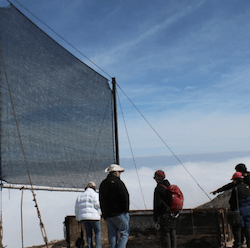
In isolated areas of Southwestern Morocco, Berber communities have faced severe drought for the past 30 years. Particularly during the hot months of June to August, villages are challenged with a water crisis that dates back to the 1980s. In 1986, desertification began and rainfall decreased by 80% in Southern Morocco.
Historically, Berber women had the daunting task of walking in the heat for 3 miles to collect water and transporting it back to their villages by placing a jug on their head. The drought created a significantly worse situation whereby these women walked for miles only to discover depleted wells.
UN awards Morocco project as the world’s largest fog harvester.
Fortunately, the water crisis has sparked innovation and creativity among members of the Moroccan community. Aïssa Derhem, the son of Berber villager heard about the bleak situation. He remembered during the years he lived in Canada learning about Fogquest, a company who captured fog and transformed it into water.
Upon returning to Morocco, Derhem established the nonprofit organization, Dar Si Hmad, and in 2000, he teamed up with FogQuest to set up a water system in Morocco.
Together they established the first Fog Collector on top of Mt. Boutmezguida in the Anti Atlas Mountains, The official experiment began in 2006. Seven reservoirs were built, 600 square meters of mesh netting was distributed, and 10,000 pipelines were extended to reach nine villages. In 2016, the UN awarded the project and named them as the world’s largest fog harvester.
